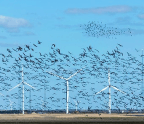Following the messenger



High-tech bird tracking is taking rapid flight in an era of global scientific cooperation. Birds as small as warblers are signaling their locations from breeding and wintering grounds, from stopovers and long migrations thanks to ever-more-sophisticated miniaturized tracking devices. Scientists harness the power of the sun, satellites, automated radio telemetry, and even the International Space Station to follow birds like never before.
At stake? The future of bird life on Earth. Three billion birds lost since 1970 in North America is incentive alone for scientists coming together and to assure that critical technology is affordable and accessible.
“We don’t have a lot of time,” says Pete Marra, director of the Georgetown Environment Initiative. “Many species are declining right before our eyes, and we don’t know why.”
Marra is thrilled to see tracking tools applied to smaller and smaller species that help scientists come closer to understanding the full annual and life cycle of birds. While each technology has its pros and cons, together the tools are unraveling mysteries of what birds do when they vanish from our view.
KIRTLAND’S WARBLER SURPRISE
Wearing tiny radio transmitter backpacks, 100 Kirtland’s Warblers guided Smithsonian and Georgetown University scientists to a conservation revelation in 2020. Far from staying put after a 1,700-mile trek from the Bahamas to northern Michigan’s scrubby Jack pine forests, some of these rare warblers kept winging long distances and often at night.
Applying the Motus Wildlife Tracking System, an international collaborative research network that uses automated radio telemetry, biologists analyzed surprising location data from birds bearing uniquely coded nanotags.
Lead researcher Nathan Cooper of the Smithsonian Migratory Bird Center found that 11 percent of the breeding birds and 60 percent of non-breeders explored much more than the few miles he expected they’d fly within their specialized habitats.
“I was pretty shocked,” Cooper says. “I’ve been interested
You’re reading a preview, subscribe to read more.
Start your free 30 days





